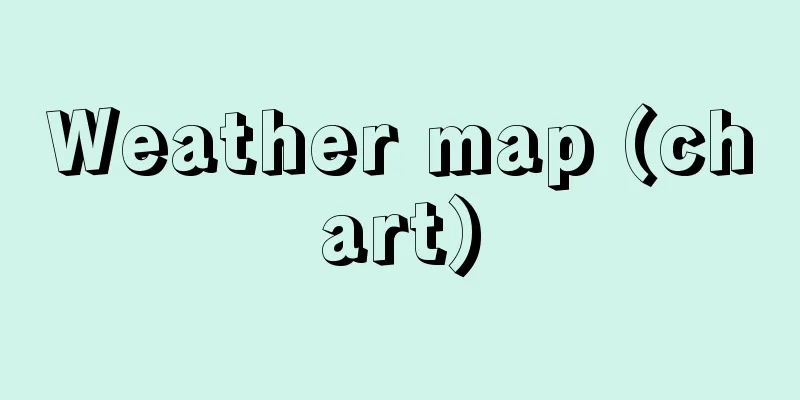Weather map (chart)

|
A map showing atmospheric conditions over a wide area at a certain time using numbers, symbols, contour lines, etc. By creating weather charts continuously at regular intervals, it is possible to understand temporal changes in atmospheric conditions and to elucidate the mechanisms that cause these changes. The English word for weather chart, synoptic, means "to look over at the same time," emphasizing the ability to see at a glance the weather conditions over a wide area at the same time. Synoptic charts are also sometimes called synoptic charts. The field of meteorology that uses weather charts to study weather over a wide area and apply them to weather forecasting is called synoptic meteorology. [Atsushi Kurashima and Takashi Aoki] History of Weather MapsThe first weather chart was made by German physicist Brandes in the early 19th century, but the date on that chart was March 6, 1783, more than 25 years before the time of the weather forecast, and it was not practical for weather forecasting. As the use of telegraphs spread rapidly in the 1840s, it became possible to collect weather conditions in various places quickly, and in 1848, the British newspaper "Daily News" began to publish weather tables. In the United States, attempts were made to collect weather information by telegraph the following year, and in 1858, a weather chart based on this information was published. However, these businesses were run by private individuals and did not develop very much. This is because making weather charts requires a large investment in the construction, maintenance, and operation of observation and communication networks, and weather charts did not generate direct profits that were commensurate with the investment. Today, meteorological businesses are run by governments in many countries around the world, because while meteorological businesses can be established if they are aimed at the public interest, they cannot be established as profit-making businesses. The establishment of private meteorological companies in developed capitalist countries also presupposes the free provision of vast amounts of meteorological data by state meteorological agencies. The trigger for the creation of weather charts as a national task was a severe storm that struck the Crimean Peninsula on November 14, 1854. The storm caused serious damage to the British and French combined fleet, which was taking part in the Crimean War at the time, off the coast of Balaclava, and sank the state-of-the-art French steel ship, the Henri IV. The French government ordered Le Verrier, director of the Paris Observatory, to investigate the possibility of predicting the storm. Together with his assistant, Rias, he ordered about 250 meteorological records from various observatories in Europe, created a weather chart, and revealed that the storm was caused by a low pressure system that had moved from Spain through the Mediterranean Sea to the Black Sea. The French government then realized that the presence or absence of a weather chart could determine the fate of a country. Le Verrier and his team began to publish daily weather charts in 1863, and other civilized countries around the world followed suit and began full-scale meteorological projects. In Japan, the Tokyo Meteorological Observatory, the predecessor of the current Japan Meteorological Agency, was officially established on June 1, 1875 (Meiji 8) (this is the origin of the Meteorological Memorial Day), but the first weather chart was produced on February 16, 1883, printed and published on March 1, and has been published daily since then. At that time, there were only 11 weather stations in the entire country. [Atsushi Kurashima and Takashi Aoki] Weather symbols and weather chart formatsOn a weather chart, the weather, meteorological elements, and other physical quantities that represent the atmospheric conditions at each location are written in or near the location circle using weather symbols and numbers. There are certain rules for how to write the weather chart, which is called the weather chart format. There are two types of weather symbols and weather chart formats: the international style and the Japanese style. The international style was decided under the coordination of the World Meteorological Organization, is common to all countries, and shows weather conditions in detail. It is used by specialized organizations such as the Japan Meteorological Agency, and is also used for weather charts in radio facsimile broadcasts (fax broadcasts) used on ships, etc. The Japanese style is used for weather charts made by ordinary people in Japan for weather reports on the radio, for flash weather charts provided to the general public by the Japan Meteorological Agency, and for weather charts in newspapers. [Atsushi Kurashima and Takashi Aoki] Weather Map AnalysisWeather map analysis involves drawing isobars and isotherms on a map that lists the weather and meteorological elements at each location, determining the locations of high pressure systems, low pressure systems, typhoons, and fronts, identifying air masses, and clarifying their movements. The results of the analysis are expressed using weather map analysis symbols. In addition to the usual weather map analyses such as isobar analysis, air mass analysis, and front analysis, there are also special analyses such as streamline analysis, isotach analysis, and cloud analysis (Neph analysis). [Atsushi Kurashima and Takashi Aoki] Types of Weather MapsDepending on the area of analysis, there are local weather charts, Far Eastern weather charts, Asia-Pacific weather charts, Northern Hemisphere weather charts, and global weather charts. Since normal high pressure systems, low pressure systems, and fronts move about 1000 km per day, Far Eastern weather charts are suitable for 24-48 hour forecasts, while Northern Hemisphere weather charts are needed for weekly forecasts. Asia-Pacific weather charts are used to track typhoons and issue maritime warnings to ships in the Pacific Ocean. Local weather charts are large maps of small areas, such as the Kanto region or the Tokyo area, and are used to capture the movements of meso-high pressure systems and meso-low pressure systems, which have a much smaller spatial and temporal scale than normal high and low pressure systems, and to forecast thunderstorms and heavy rains. Local weather charts are also used to track the detailed movements of typhoons approaching or landing in Japan on an hourly basis. Weather charts are broadly divided into surface weather charts and upper air weather charts, depending on the surface that depicts the atmospheric conditions. Upper air weather charts are usually created for several isobaric surfaces, and are called isobaric surface weather charts. The contour lines drawn on an isobaric surface weather chart correspond to the isobars of the constant height surface in the vicinity. In addition, isotherms are sometimes drawn and streamlines are drawn (called streamline analysis), and iso-wind lines are drawn and the position of the jet stream is analyzed. This is called iso-wind line analysis. Weather charts of isentropic surfaces are sometimes created. Weather charts in the broad sense also include maps showing the distribution of meteorological elements such as precipitation and air pressure change, and physical quantities such as vorticity, divergence, updrafts, and water vapor transport. In particular, maps showing the distribution of physical quantities have become practical thanks to the development of meteorological and thermodynamic theories and the use of large, high-speed electronic computers, and are extremely important for understanding the state and structure of the atmosphere and for weather forecasting. Special weather charts include the Neph chart, which shows the characteristics of cloud distribution, and there are also charts that depict the locations of fronts, high pressure systems, and low pressure systems on cloud photographs obtained from meteorological satellites. These analyses are called cloud analysis. A chart showing the distribution of future meteorological elements and various physical quantities is called a prognostic chart, which is distinguished from a current weather chart. In addition, there are average weather charts, which are mainly used for long-term forecasts. These are divided into time-averaged and space-averaged. In addition, a continuous chart is a chart that shows the progress of atmospheric conditions over time on a single chart, such as by selecting centers of high and low pressure systems, fronts, pressure troughs, specific isobars, and specific isotherms from a series of weather charts that are consecutive in time and plotting them on a single weather chart. [Atsushi Kurashima and Takashi Aoki] How to read surface weather chartsWhen using weather charts from newspapers, television, etc., or weather charts you have created yourself using radio weather reports, it is important to keep the following in mind. (1) Understand weather symbols and weather chart analysis symbols. (2) To understand the relationship between the type of isobars and the wind direction and weather distribution, and to be able to roughly estimate the weather in areas without weather symbols. Where isobars are densely packed, the pressure gradient is large and the wind is strong. In the Northern Hemisphere, wind blows from high pressure to low pressure, crossing the isobars at a certain angle (30-40 degrees on land and 15-30 degrees at sea in the temperate zone), with high pressure to the right and low pressure to the left. In the vicinity of Japan, when the interval between isobars drawn every 2 hectopascals is about 1 degree of latitude (about 110 kilometers), the wind speed at sea is about 8-10 meters per second (wind force 5). This relationship between isobars and wind applies to a large-scale wind system, and at individual points, this relationship can be significantly disturbed due to the influence of topography, etc. However, the application of this relationship is important in determining the movement of large-scale air masses and the fall (cold waves) or rise (warm waves) of temperatures over a wide area from the pressure distribution. As can be seen from , wind blows out from high pressure and pressure peaks (divergent air currents), which means that downdrafts are dominant and sunny weather is likely to occur. On the other hand, wind blows into low pressure and pressure troughs (convergent air currents), which means that updrafts are dominant and precipitation is likely to occur. Also, if the characteristics of the air currents blowing in are different, a front will form where they meet. On the other hand, even if a front exists at a high pressure or pressure ridge, the air masses on both sides move away from each other, so the front will disappear. (3) Instead of looking at just one weather chart, line up weather charts from the past 3 to 4 days and observe the movement of high and low pressure systems and fronts (whether they are moving at a constant speed, accelerating, or decelerating) and their development and weakening, and try to think about each movement in the future. (4) Utilizing periodicities and similarities that appear in changes in weather charts. By pasting newspaper weather charts in a scrapbook or similar and looking at changes in the weather charts over the past one or two months, you may notice that similar weather charts appear periodically and change in the same way. By utilizing such periodicities, it is possible to extend the forecast period by about one week. Also, by selecting a similar weather chart to the current one from many weather charts for the same season not only for the current year but for each past year, and looking at the weather chart for the next day, you can imagine the type of weather chart tomorrow. In this case, it is best to select similar weather charts that show similar changes to the current one over two or three days, not just one day. (5) Be familiar with the typical atmospheric pressure patterns, such as high pressure in the west and low pressure in the east, high pressure in the south and low pressure in the north, rainy season type, etc., and their characteristics. (6) First, "practice makes perfect." Rather than trying to use a weather chart after thoroughly reading a meteorological book, first look at a weather chart, find the changes in its shape for yourself, and then try to use it in your own way by relating it to daily weather changes. After that, read a meteorological book and think about the basis for the forecasting rules you have discovered. It is good to become familiar with weather charts by repeating this process. [Atsushi Kurashima and Takashi Aoki] Upper air weather charts and forecastsIn the Northern Hemisphere, winds blow almost parallel to the contours of an isobaric weather chart, with high pressure to the right and low pressure to the left. Looking broadly at the upper tropospheric weather chart in the Northern Hemisphere above 700 hectopascals (about 3,000 meters), the Arctic Circle is a huge low pressure zone, and the subtropics are a high pressure zone. Many of the isobaric contour lines in the temperate zone stretch long from west to east, circling the Northern Hemisphere. And in the temperate zone, westerly winds blow along these contour lines. These westerly winds meander north and south, and the contour lines also meander north and south accordingly. In this meandering, the parts of the contour lines that protrude south are pressure troughs extending south from the low pressure zone in the Arctic region, and the parts that protrude north are pressure ridges extending north from the high pressure zone in the subtropics. Many of these low-pressure troughs and ridges move eastward at a speed of about 10 degrees longitude (about 1,000 kilometers) per day. Low pressure systems tend to develop on the surface diagonally east of the valleys, and high pressure systems tend to develop on the surface diagonally east of the ridges. These low and high pressure systems move eastward along with the westerly wind waves in the sky, with the low pressure systems tending to move northward and the high pressure systems tending to move southward. Even if the high and low pressure systems on the surface disappear, the westerly wind waves in the sky continue to move eastward, and when they reach areas where low and high pressure systems are prone to form, they create new low and high pressure systems there. In addition to the mobile westerly wind waves depicted on upper-level weather charts, there are also very long waves with longer wavelengths. Many of these are stationary, and sometimes they move back westward or increase in amplitude, causing blocking phenomena. The eastern side of the very long wave trough corresponds to an area where low pressure systems are likely to develop when a mobile trough passes through, and a family of low pressure systems is likely to form on the front stretching from the northeast to the southwest, with weakened low pressure systems, developed low pressure systems, and low pressure systems in the early stages of development lined up in sequence. Ground pressure systems (high pressure systems, low pressure systems, typhoons, etc.) are carried by the winds in the sky, just as whirlpools in a river move with the current of the river. From this perspective, the air currents depicted on upper air weather charts are regarded as directional currents (or general currents) that govern the movement of ground pressure systems, and serve as a guide to predicting their course. Thus, upper air weather charts have become indispensable for modern weather forecasts, and in computer-based numerical forecasts, in addition to surface weather charts, many upper air weather charts are also produced. [Atsushi Kurashima and Takashi Aoki] How to draw a weather mapOrdinary people can make their own weather charts by using radio weather reports. The contents of NHK Radio's weather reports are in the following order: (1) wind direction, wind force, weather, atmospheric pressure, and temperature in each area; (2) wind direction, wind force, weather, atmospheric pressure for ships; and (3) fishing weather. The fishing weather report broadcasts the locations of typhoons, low pressure systems, and high pressure systems, their central pressure, direction and speed, the predicted locations of typhoons and strong low pressure systems 24 hours from now and the radius of the forecast circle showing the margin of error, and the points where fronts and specific isobars pass. Weather chart paper is commercially available, and the broadcast locations and their order are fixed, so until you get used to it, it is a good idea to record the broadcast or take notes of the main points, and then slowly create a weather chart after the broadcast has finished. Commercially available weather charts have columns printed on them that are convenient for taking notes. The Japan Meteorological Agency's website also has the manuscripts of the weather reports that have been broadcast. Wind direction and wind strength in each area are recorded using weather symbols and a weather chart format. It is best to write these in ink. If you write them in pencil, you will likely erase the isobars later when drawing them, as you will use an eraser multiple times. In most cases, only the last two digits of atmospheric pressure are broadcast. When writing on a weather chart, you only need to write the tens and ones of hectopascals, for example, 15 for 1015 hectopascals, 92 for 992 hectopascals, etc. Isobars are drawn in a similar manner to contour lines on a topographical map, by dividing the atmospheric pressure at each point by the corresponding value. In this case, the isobars should be drawn without any inconsistencies in the nature of the isobars, which are based on the continuity of gases and the characteristics of the high and low pressure systems. Note that the atmospheric pressure values at each point on a weather map are rounded off to the nearest whole number, so for example, an isobar of 1012 hectopascals does not necessarily pass directly above a point marked 12. In addition, isobars are drawn using the relationship between wind and isobars, but it should be noted that the wind observed in reality may deviate from this relationship due to the influence of the terrain, etc. It is best to draw the lines roughly and boldly, without getting too caught up in the details, in order to show the general trend of the atmospheric pressure distribution. [Atsushi Kurashima and Takashi Aoki] "How to Read Weather Charts for Disaster Prevention Personnel" by Kurashima Atsushi and Aoki Takashi (1976, Tokyodo Publishing)" ▽ "Revised, Easy-to-Understand Weather Charts" (1979), edited and published by the Japan Weather Association" ▽ "The History of Weather Charts" by Saito Naosuke (1982, Tokyodo Publishing)" ▽ "How to Read Weather Charts for Weather Forecasting" by Shimoyama Norio (1998, Tokyodo Publishing)" ▽ "How to Read and Enjoy Weather and Weather Charts" edited by Kimura Ryuji (2004, Seibido Publishing)" ▽ "Illustrated Encyclopedia of How Meteorology and Weather Works" edited by Aoki Takashi (2009, Seibido Publishing)" [Reference] | | | | | | | | | | | | | | | | |©Shogakukan "> Isothermal lines and wind Source: Shogakukan Encyclopedia Nipponica About Encyclopedia Nipponica Information | Legend |
|
広い範囲のある時刻の大気の状態が、数字、記号、等値線などによって表現されている地図。天気図を一定時間間隔で連続して作成すると、大気の状態の時間的変化がわかり、またその変化をおこす「仕組み」を解明することができる。天気図を英語で表したときのsynopticは「同時に見渡す」という意味で、同時刻の広範囲の気象状態を一目で見渡すことを強調したものである。synoptic chartは総観図とよばれることもある。天気図を用いて広範囲の気象を研究し天気予報に応用する気象学の分野を総観気象学という。 [倉嶋 厚・青木 孝] 天気図の歴史最初の天気図は19世紀の初めにドイツの物理学者ブランデスによってつくられたが、その天気図の日付は当時よりさらに25年以上も前の1783年3月6日のもので、天気予報の実用にはなりえなかった。1840年代になり電信の利用が急速に広まるにつれて、各地の気象状況を迅速に集信することが可能になり、1848年にイギリスの『デーリー・ニュース』紙が天気の一覧表を載せ始めた。アメリカでも翌年から気象資料の電信による集信が試みられ、1858年には、これを天気図にしたものが発表されている。しかし、これらの事業は民間人によって行われたため、あまり発展しなかった。というのは、天気図をつくるためには、観測網と通信網の建設・維持・経営に多大の投資を必要とするが、それに見合う直接の利潤を天気図は生み出さなかったからである。今日、気象事業は世界各国とも国家が行っているが、これは気象事業が公益を目的とする場合は成立しうるが、営利事業としては成り立たないためである。先進資本主義国における民間気象会社の成立も、国家の気象事業からの膨大な気象資料の無料提供を前提としている。 国家の仕事としての天気図の作成のきっかけをつくったのは、1854年11月14日にクリミア半島を襲った大暴風である。これにより、当時、クリミア戦争に参加していた英仏連合艦隊はバラクラバ沖で大損害を受け、鋼鉄製のフランス最新鋭艦アンリ4世号が沈没した。フランス政府は、この暴風の予測の可能性の調査をパリの天文台台長ルベリエに命じた。彼は助手のリアスとともにヨーロッパの各観測所から250通ほどの気象記録を取り寄せ、天気図をつくり、この暴風が、スペイン付近から地中海を通って黒海に進んできた低気圧によっておこされたことを明らかにした。そしてフランス政府は、天気図の有無が国運を左右しうることを認識する。ルベリエたちによって日々の天気図が公刊され始めたのは1863年で、その後、世界の文明国がこれに倣って気象事業を本格的に開始した。 日本では、現在の気象庁の前身にあたる東京気象台が正式に発足したのが1875年(明治8)6月1日(気象記念日はこれに由来する)であるが、初めて天気図がつくられたのは1883年2月16日のことで、3月1日には印刷して発行され、この日以後毎日刊行されるようになった。当時は全国でわずか11か所の測候所しかなかった。 [倉嶋 厚・青木 孝] 天気記号と天気図記入形式天気図上では各地点の天気、気象要素、必要に応じてその他の大気の状態を表す各種物理量が、天気記号や数字で、地点円の中または近傍に記入される。記入の仕方にも一定の約束があり、これを天気図記入形式という。天気記号および天気図記入形式には国際式と日本式がある。国際式は世界気象機関の調整のもとに決められており、万国共通で、天気の状態が詳細に表される。これは気象庁など専門の機関で用いられ、また船舶などで利用される無線模写放送(ファクシミリ放送)の天気図にも用いられている。日本式は、ラジオの気象通報などで国内の一般の人がつくる天気図や、気象庁が一般向けに提供する速報天気図、新聞天気図などに用いられている。 [倉嶋 厚・青木 孝] 天気図解析各地点の天気や気象要素などが記入された地図に等圧線や等温線を引き、高気圧、低気圧、台風、前線の位置を決め、気団を判別し、それらの動きを明らかにすることを天気図解析という。解析結果は天気図解析記号で表現される。天気図解析には等圧線解析、気団解析、前線解析などの通常の解析のほかに、流線解析、等風速線解析(アイソタック・アナリシスisotach analysis)、雲解析(ネフ・アナリシスneph analysis)など特別の解析がある。 [倉嶋 厚・青木 孝] 天気図の種類解析する範囲により局地天気図、極東天気図、アジア太平洋天気図、北半球天気図、全球天気図などがある。普通の高気圧、低気圧、前線などは1日に1000キロメートル程度の距離を移動するから、極東天気図は24~48時間予報に使うのに適しており、週間予報には北半球天気図が必要である。アジア太平洋天気図は台風の追跡や太平洋上の船舶に対する海上警報を行うのに用いられる。局地天気図は、たとえば関東地方とか東京都周辺などのように狭い範囲を大きな地図にして、アメダスのような細かいネットの観測値を記入し、空間的、時間的なスケールが普通の高・低気圧よりはるかに小さなメソ高気圧、メソ低気圧などの動きをとらえ、雷雨や集中豪雨を予報するのに用いられる。また日本に接近・上陸した台風の詳細な動きを1時間ごとに追跡するのにも、局地天気図が用いられる。 天気図は、大気の状態を描き出す面によって、地上天気図と高層天気図に大別される。高層天気図は通常いくつかの等圧面について作成され、これを等圧面天気図という。等圧面天気図に描かれる等高線は、その付近の定高度面の等圧線に相当する。このほかに等温線が引かれ、流線が描かれること(流線解析という)や、また等風速線が描かれ、ジェット気流の位置が解析される。これを等風速線解析という。等温位面の天気図がつくられることもある。 雨量、気圧変化量などの気象要素や、渦度(うずど)、発散、上昇気流、水蒸気輸送量などの物理量の分布を図にしたものも、広義の天気図である。とくに物理量の分布図は気象力学・熱力学の理論の発展と、大型高速度電子計算機の利用によって、その実用化が可能になったもので、大気の状態や構造を理解して天気予報を行うのにきわめて重要な天気図になっている。特別の天気図には、雲分布の特徴を表したネフ・チャートneph chartがあり、また気象衛星から得られた雲写真に前線や高気圧、低気圧の位置などを描いたものもある。これらの解析を雲解析という。 将来の気象要素や各種物理量の分布を描き出したものは予想天気図prognostic chartとよばれ、実況天気図と区別される。そのほかに、主として長期予報に用いられる平均天気図がある。これには時間平均したものと空間平均したものとがある。 また、時間的に連続した天気図から、高・低気圧の中心、前線、気圧の谷、特定等圧線、特定等温線などを選び、1枚の天気図上に記入するなど、大気の状態の時間的経過を1枚の図に表したものを連続図という。 [倉嶋 厚・青木 孝] 地上天気図の見方新聞・テレビなどの天気図や、ラジオの気象通報により自分でつくった天気図を利用するためには、次の心得がたいせつである。 (1)天気記号、天気図解析記号を理解しておくこと。 (2)等圧線の形式と風の吹き方および天気分布についての関係を知り、天気記号の記入されていない地域の天気を大まかに推定できるようになること。等圧線が密集しているところでは気圧傾度が大きく、風が強い。風は、北半球においては、高気圧を右に、低気圧を左にみるような形で、気圧の高いほうから低いほうに向かって、等圧線をある角度(温帯では陸上で30~40度、海上で15~30度)で横切って吹く。日本付近では2ヘクトパスカルごとに引いた等圧線の間隔が緯度にして1度(約110キロメートル)ぐらいあると、風速は海上で毎秒8~10メートル(風力5)ぐらいになる。等圧線と風のこのような関係は、大規模な風系に当てはまることであり、個々の地点では地形などの影響で、この関係が著しく乱れてしまうことがある。しかし気圧分布から、大規模な気団の動きや、広い範囲での気温の下降(寒波)や上昇(暖波)を判断するのには、この関係の応用が重要である。からもわかるように、高気圧や気圧の峰からは風が吹き出しており(発散気流)、したがって下降気流が卓越し、晴天になりやすい。一方、低気圧や気圧の谷には風が吹き込んでおり(収束気流)、したがって上昇気流が卓越し、降水現象がおこりやすい。また吹き込んでくる気流の性質が異なる場合は、その触れ合うところに前線ができる。一方、高気圧や気圧の尾根では、たとえ前線があっても、両側の気団が離れていくから、前線は消滅する。 (3)1枚だけの天気図をみるのではなく、過去3~4日分の天気図を並べて、高・低気圧や前線の動き(等速か加速か減速か)や発達・衰弱のようすを観察し、それぞれの動きを先に延ばして考えてみること。 (4)天気図の変化に現れる周期性や類似性を利用すること。新聞天気図をスクラップ・ブックなどに貼(は)って、過去1~2か月間の天気図の変化をみると、同じような型の天気図が周期的に現れ、同じように変化していることに気づくことがある。このような周期性を利用すると、予報期間を1週間程度延長することができる。また、その年だけでなく、過去の各年の同じ季節の多数の天気図のなかから、現在の天気図と似た型を選び出し、その翌日の天気図をみれば、明日の天気図の型が想像できる。この場合の類似天気図は、1日だけでなく2~3日間の変化が現在と似ているものを選び出すのがもっともよい。 (5)西高東低型、南高北低型、梅雨型、……などとよばれている典型的な気圧配置の型と、その性質をよく知っておくこと。 (6)まず「習うより慣れる」こと。気象学の本をよく読んでから天気図を使おうとするよりは、まず天気図を眺め、その形の変化を自分自身でみつけ、それを日々の天気変化に対応させて、自分なりに使い方をつくりだしてみる。そのあとで気象学の本を読んで、自分がみいだした予報則の根拠を考えてみる。そのような繰り返しで天気図に慣れていくのがよい。 [倉嶋 厚・青木 孝] 高層天気図と天気予報上空の風は、北半球では高気圧を右、低気圧を左にみながら、等圧面天気図の等高線にほとんど並行に吹いている。700ヘクトパスカル(約3000メートル)から上空の北半球における対流圏の高層天気図は、大きくみると、北極圏上空が巨大な低気圧になっており、亜熱帯が高圧帯となっている。温帯上空の等圧面の等高線は、西から東へ長く伸びて北半球を一周しているものが多い。そして温帯上空では、これらの等高線に沿って偏西風が吹いている。この偏西風は南北に蛇行しながら流れており、これに対応して等高線も南北に蛇行している。この蛇行で、等高線が南に突出する部分は北極方面の低気圧から南に伸びる気圧の谷(トラフtrough)、北に突出する部分は亜熱帯の高圧帯から北に伸びる気圧の尾根(リッジridge)となっている。これらの気圧の谷や尾根は、1日に経度にして約10度(約1000キロメートル)の速度で東進するものが多い。そして谷の斜め東側の地上には低気圧、尾根の斜め東側の地上に高気圧が発達しやすく、これらの低気圧・高気圧は上空の偏西風波動とともに、低気圧は北向き、高気圧は南向きの成分をもちながら東進する。そして地上の高・低気圧が消滅しても、上空の偏西風波動は東進を続け、低気圧や高気圧の発生しやすい地域に行くと、そこでまた新しい低気圧や高気圧をつくる。 高層天気図に描き出される偏西風波動には、前述の移動性のもののほかに、もっと波長の長い超長波がある。これには停滞性のものが多く、ときには西へ逆行したり、振幅を増大させて、ブロッキング現象をおこしたりする。超長波の谷の東側は、移動性の谷が通るとき、低気圧が発生しやすい場所に相当し、北東から南西に伸びる前線上に、衰弱した低気圧、発達した低気圧、発生初期の低気圧が順に並んだ状態の低気圧家族ができやすい。 地上の気圧系(高気圧、低気圧、台風など)は、川の渦巻が川の流れとともに動くように、上空の風に流されて動く。この観点から、高層天気図に描き出される気流系は、地上の気圧系の動きを支配する指向流(または一般流)とみなされ、進路予想の目安となっている。このように高層天気図は、現代の天気予報には必要欠くべからざるものになっており、コンピュータによる数値予報でも、地上天気図のほかに、数多くの高層天気図の予想図がつくられている。 [倉嶋 厚・青木 孝] 天気図の書き方一般の人が自分で天気図をつくるには、ラジオの気象通報を利用する。 NHKラジオの気象通報の放送内容は、(1)各地の風向、風力、天気、気圧、気温、(2)船舶の風向、風力、天気、気圧、(3)漁業気象、の順になっている。漁業気象では、台風、低気圧、高気圧の位置、中心気圧、進行方向と速さ、台風と強い低気圧の24時間後の予想位置とその誤差範囲を示す予報円の半径、前線と特定の等圧線の通る点などが放送される。天気図用紙は市販されており、放送地点とその順序は決まっているので、慣れないうちは放送を録音したり、要点をメモして、放送が終わってから、ゆっくりと天気図を作成するとよい。市販の天気図には、メモに便利な欄が印刷されている。また、気象庁のホームページには、放送された気象通報の原稿が載っている。 各地の風向、風力などは、天気記号と天気図記入形式で記入する。これらはインクで記入したほうがよい。鉛筆で記入すると、あとで等圧線を引くときに、何度も消しゴムを使ううちに、いっしょに消してしまうことが多いからである。気圧は下の2桁(けた)の数字しか放送されない場合が多い。天気図に記入する場合も、たとえば1015ヘクトパスカルの場合は15、992ヘクトパスカルの場合は92のようにヘクトパスカルの10位と1位を記入すればよい。 等圧線は各地点の気圧の値から案分して、地形図の等高線を引くのとよく似た要領で描く。この場合、気体の連続性や高気圧・低気圧の気圧系の特性からくる等圧線の性質に矛盾のないように引く。なお天気図に記入されている各地点の気圧の値は小数点以下が四捨五入してあるから、たとえば1012ヘクトパスカルの等圧線が、12と記入されている地点の真上をかならず通るとは限らない。また風と等圧線の関係を利用して引くが、実際に観測される風は、地形などの影響により、この関係から外れている場合のあることにも留意し、あまり細部にとらわれず、気圧分布の大勢を表すのを目的として、大まかな案分で大胆に線を引くとよい。 [倉嶋 厚・青木 孝] 『倉嶋厚・青木孝著『防災担当者のための天気図の読み方』(1976・東京堂出版)』▽『日本気象協会編・刊『改訂 わかりやすい天気図の話』(1979)』▽『斎藤直輔著『天気図の歴史』(1982・東京堂出版)』▽『下山紀夫著『気象予報のための天気図のみかた』(1998・東京堂出版)』▽『木村龍治監修『気象・天気図の読み方・楽しみ方』(2004・成美堂出版)』▽『青木孝監修『図解 気象・天気のしくみがわかる事典』(2009・成美堂出版)』 [参照項目] | | | | | | | | | | | | | | | | |©Shogakukan"> 等圧線の形式と風〔図〕 出典 小学館 日本大百科全書(ニッポニカ)日本大百科全書(ニッポニカ)について 情報 | 凡例 |
<<: Electricity tax/Gas tax - Electricity tax/Gas tax
>>: Legendary New Record - Electricity Symbol
Recommend
Streblidae
…A general term for insects belonging to the Stre...
Onnekotan Island - Onekotanto
A volcanic island in the northern part of the Kur...
Sofronie (English spelling) Brachanski Sofronij
1739‐1813 Pioneer of the Bulgarian national reviva...
Ibn Ḥawqal
Geographer of the 10th century. His biography and ...
Management Spring Offensive
...Although the postwar labor movement has develo...
nephridium
…The kidney is an excretory organ common to all v...
Atash Kadeh - Atash Kadeh
… There are about 50 known Zoroastrian fire templ...
Kanmuriyama Mountains
This mountain range forms the western edge of the ...
Single thread - 1 start thread
…When a screw rotates once around its axis, the t...
Wessel Gansfort
Around 1419-89 Dutch humanist. Also known as Johan...
Taiki [town] - Taiki
A town in Hiroo County, Hokkaido. It lies between ...
Shigure Hasegawa
Playwright. Real name Yasu. Born in Nihonbashi, T...
Amos - Amos (English spelling)
Amos was a prophet who appeared in Israel in the ...
Chalukya Dynasty - Chalukyacho (English spelling)
A dynasty in South India. It is divided into thre...
Obi [river] - Obi
A river in Western Siberia, Russia. It originates ...


![Minori [town] - Minori](/upload/images/67ccf52171e49.webp)






